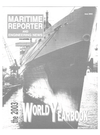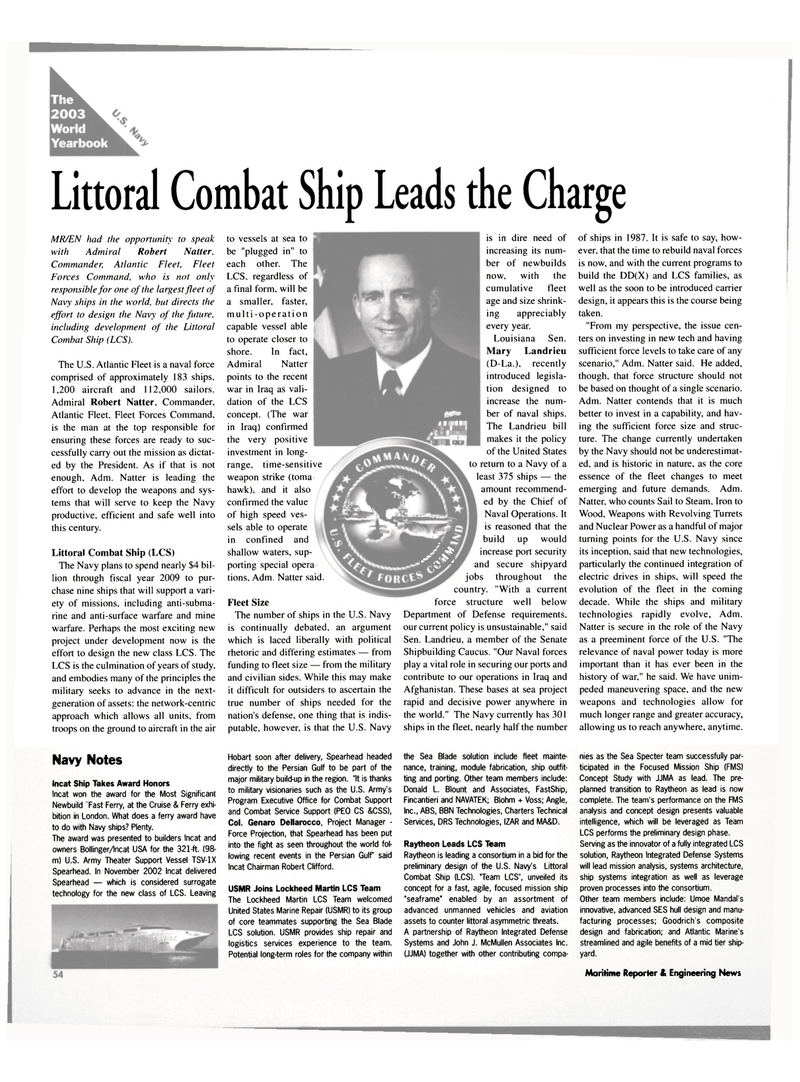
Page 54: of Maritime Reporter Magazine (June 2003)
Read this page in Pdf, Flash or Html5 edition of June 2003 Maritime Reporter Magazine
Littoral Combat Ship Leads the Charge to vessels at sea to be "plugged in" to each other. The
LCS. regardless of a final form, will be a smaller, faster, multi-operation capable vessel able to operate closer to shore. In fact,
Admiral Natter points to the recent war in Iraq as vali- dation of the LCS concept. (The war in Iraq) confirmed the very positive investment in long- range, time-sensitive weapon strike (toma hawk), and it also confirmed the value of high speed ves- sels able to operate in confined and shallow waters, sup- porting special opera tions. Adm. Natter said.
Fleet Size
The number of ships in the U.S. Navy is continually debated, an argument which is laced liberally with political rhetoric and differing estimates — from funding to fleet size — from the military and civilian sides. While this may make it difficult for outsiders to ascertain the true number of ships needed for the nation's defense, one thing that is indis- putable. however, is that the U.S. Navy /A is in dire need of increasing its num- ber of newbuilds now, with the cumulative fleet age and size shrink- ing appreciably every year.
Louisiana Sen.
Mary Landrieu (D-La.), recently introduced legisla- tion designed to increase the num- ber of naval ships.
The Landrieu bill makes it the policy of the United States to return to a Navy of a least 375 ships — the amount recommend- ed by the Chief of
Naval Operations. It is reasoned that the build up would increase port security and secure shipyard jobs throughout the country. "With a current force structure well below
Department of Defense requirements, our current policy is unsustainable," said
Sen. Landrieu, a member of the Senate
Shipbuilding Caucus. "Our Naval forces play a vital role in securing our ports and contribute to our operations in Iraq and
Afghanistan. These bases at sea project rapid and decisive power anywhere in the world." The Navy currently has 301 ships in the fleet, nearly half the number
MR/EN had the opportunity• to speak with Admiral Robert Natter,
Commander, Atlantic Fleet, Fleet
Forces Command, who is not only responsible for one of the largest fleet of
Navy ships in the world, but directs the effort to design the Navy of the future, including development of the Littoral
Combat Ship (LCS).
The U.S. Atlantic Fleet is a naval force comprised of approximately 183 ships, 1,200 aircraft and 112,000 sailors.
Admiral Robert Natter, Commander,
Atlantic Fleet, Fleet Forces Command, is the man at the top responsible for ensuring these forces are ready to suc- cessfully carry out the mission as dictat- ed by the President. As if that is not enough, Adm. Natter is leading the effort to develop the weapons and sys- tems that will serve to keep the Navy productive, efficient and safe well into this century.
Littoral Combat Ship (LCS)
The Navy plans to spend nearly $4 bil- lion through fiscal year 2009 to pur- chase nine ships that will support a vari- ety of missions, including anti-subma- rine and anti-surface warfare and mine warfare. Perhaps the most exciting new project under development now is the effort to design the new class LCS. The
LCS is the culmination of years of study, and embodies many of the principles the military seeks to advance in the next- generation of assets: the network-centric approach which allows all units, from troops on the ground to aircraft in the air
Navy Notes
Incat Ship Takes Award Honors
Incat won the award for the Most Significant
Newbuild "Fast Ferry, at the Cruise & Ferry exhi- bition in London. What does a ferry award have to do with Navy ships? Plenty.
The award was presented to builders Incat and owners Bollinger/lncat USA for the 321-ft. (98- m) U.S. Army Theater Support Vessel TSV-1X
Spearhead. In November 2002 Incat delivered
Spearhead — which is considered surrogate technology for the new class of LCS. Leaving
Hobart soon after delivery, Spearhead headed directly to the Persian Gulf to be part of the major military build-up in the region. "It is thanks to military visionaries such as the U.S. Army's
Program Executive Office for Combat Support and Combat Service Support (PEO CS &CSS),
Col. Genaro Dellarocco, Project Manager -
Force Projection, that Spearhead has been put into the fight as seen throughout the world fol- lowing recent events in the Persian Gulf" said
Incat Chairman Robert Clifford.
USMR Joins Lockheed Martin LCS Team
The Lockheed Martin LCS Team welcomed
United States Marine Repair (USMR) to its group of core teammates supporting the Sea Blade
LCS solution. USMR provides ship repair and logistics services experience to the team.
Potential long-term roles for the company within the Sea Blade solution include fleet mainte- nance, training, module fabrication, ship outfit- ting and porting. Other team members include:
Donald L. Blount and Associates, FastShip,
Fincantieri and NAVATEK; Blohm + Voss; Angle,
Inc., ABS, BBN Technologies, Charters Technical
Services, DRS Technologies, IZAR and MA&D.
Raytheon Leads LCS Team
Raytheon is leading a consortium in a bid for the preliminary design of the U.S. Navy's Littoral
Combat Ship (LCS). "Team LCS", unveiled its concept for a fast, agile, focused mission ship "seaframe" enabled by an assortment of advanced unmanned vehicles and aviation assets to counter littoral asymmetric threats.
A partnership of Raytheon Integrated Defense
Systems and John J. McMullen Associates Inc. (JJMA) together with other contributing compa- of ships in 1987. It is safe to say, how- ever, that the time to rebuild naval forces is now, and with the current programs to build the DD(X) and LCS families, as well as the soon to be introduced carrier design, it appears this is the course being taken. "From my perspective, the issue cen- ters on investing in new tech and having sufficient force levels to take care of any scenario," Adm. Natter said. He added, though, that force structure should not be based on thought of a single scenario.
Adm. Natter contends that it is much better to invest in a capability, and hav- ing the sufficient force size and struc- ture. The change currently undertaken by the Navy should not be underestimat- ed, and is historic in nature, as the core essence of the fleet changes to meet emerging and future demands. Adm.
Natter, who counts Sail to Steam, Iron to
Wood, Weapons with Revolving Turrets and Nuclear Power as a handful of major turning points for the U.S. Navy since its inception, said that new technologies, particularly the continued integration of electric drives in ships, will speed the evolution of the fleet in the coming decade. While the ships and military technologies rapidly evolve, Adm.
Natter is secure in the role of the Navy as a preeminent force of the U.S. "The relevance of naval power today is more important than it has ever been in the history of war," he said. We have unim- peded maneuvering space, and the new weapons and technologies allow for much longer range and greater accuracy, allowing us to reach anywhere, anytime. nies as the Sea Specter team successfully par- ticipated in the Focused Mission Ship (FMS)
Concept Study with JJMA as lead. The pre- planned transition to Raytheon as lead is now complete. The team's performance on the FMS analysis and concept design presents valuable intelligence, which will be leveraged as Team
LCS performs the preliminary design phase.
Serving as the innovator of a fully integrated LCS solution, Raytheon Integrated Defense Systems will lead mission analysis, systems architecture, ship systems integration as well as leverage proven processes into the consortium.
Other team members include: Umoe Mandal's innovative, advanced SES hull design and manu- facturing processes; Goodrich's composite design and fabrication; and Atlantic Marine's streamlined and agile benefits of a mid tier ship- yard. 56 Maritime Reporter & Engineering News

 53
53

 55
55
